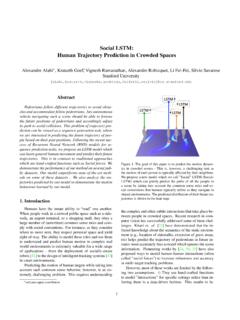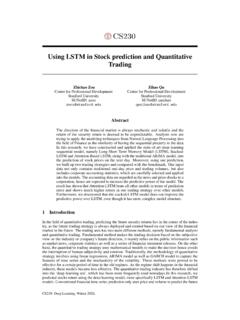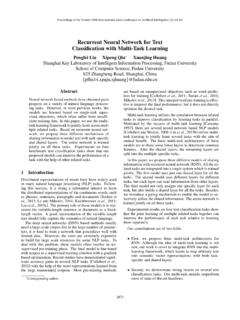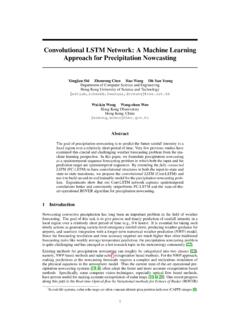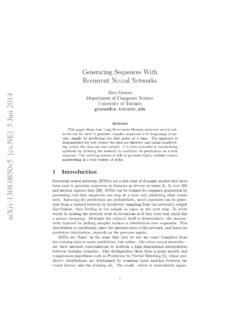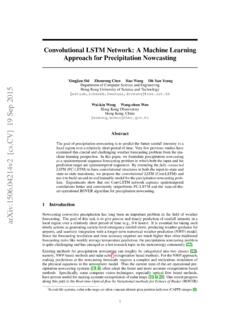Transcription of Sequence to Sequence Learning with Neural Networks
1 [ ] 14 Dec 2014 Sequence to Sequence Learningwith Neural NetworksIlya V. Neural Networks (DNNs) are powerful models that have achieved excel-lent performance on difficult Learning tasks. Although DNNswork well wheneverlarge labeled training sets are available, they cannot be used to map sequences tosequences. In this paper, we present a general end-to-end approach to sequencelearning that makes minimal assumptions on the Sequence structure. Our methoduses a multilayered long short -Term memory (LSTM) to map theinput sequenceto a vector of a fixed dimensionality, and then another deep LSTM to decode thetarget Sequence from the vector. Our main result is that on anEnglish to Frenchtranslation task from the WMT 14 dataset, the translationsproduced by the LSTM achieve a BLEU score of on the entire test set, where the LSTM s BLEU score was penalized on out-of-vocabulary words.
2 Additionally, the LSTM did nothave difficulty on long sentences. For comparison, a phrase-based SMT systemachieves a BLEU score of on the same dataset. When we usedthe LSTMto rerank the 1000 hypotheses produced by the aforementioned SMT system, itsBLEU score increases to , which is close to the previous best result on thistask. The LSTM also learned sensible phrase and sentence representations thatare sensitive to word order and are relatively invariant to the active and the pas-sive voice. Finally, we found that reversing the order of thewords in all sourcesentences (but not target sentences) improved the LSTM s performance markedly,because doing so introduced many short term dependencies between the sourceand the target sentence which made the optimization IntroductionDeep Neural Networks (DNNs) are extremely powerful machinelearning models that achieve ex-cellent performance on difficult problems such as speech recognition [13, 7] and visual object recog-nition [19, 6, 21, 20].
3 DNNs are powerful because they can perform arbitrary parallel computationfor a modest number of steps. A surprising example of the power of DNNs is their ability to sortN N-bit numbers using only 2 hidden layers of quadratic size [27]. So, while Neural Networks arerelated to conventional statistical models, they learn an intricate computation. Furthermore, largeDNNs can be trained with supervised backpropagation whenever the labeled training set has enoughinformation to specify the network s parameters. Thus, if there exists a parameter setting of a largeDNN that achieves good results (for example, because humanscan solve the task very rapidly),supervised backpropagation will find these parameters and solve the their flexibility and power, DNNs can only be appliedto problems whose inputs and targetscan be sensibly encoded with vectors of fixed dimensionality.
4 It is a significant limitation, sincemany important problems are best expressed with sequences whose lengths are not known example, speech recognition and machine translation are sequential problems. Likewise, ques-tion answering can also be seen as mapping a Sequence of wordsrepresenting the question to a1sequence of words representing the answer. It is therefore clear that a domain-independent methodthat learns to map sequences to sequences would be pose a challenge for DNNs because they require that the dimensionality of the inputs andoutputs is known and fixed. In this paper, we show that a straightforward application of the LongShort-Term memory (LSTM) architecture [16] can solve general Sequence to Sequence idea is to use one LSTM to read the input Sequence , one timestep at a time, to obtain large fixed-dimensional vector representation, and then to use anotherLSTM to extract the output sequencefrom that vector (fig.)
5 1). The second LSTM is essentially a recurrent Neural network language model[28, 23, 30] except that it is conditioned on the input Sequence . The LSTM s ability to successfullylearn on data with long range temporal dependencies makes ita natural choice for this applicationdue to the considerable time lag between the inputs and theircorresponding outputs (fig. 1).There have been a number of related attempts to address the general Sequence to Sequence learningproblem with Neural Networks . Our approach is closely related to Kalchbrenner and Blunsom [18]who were the first to map the entire input sentence to vector, and is related to Cho et al. [5] althoughthe latter was used only for rescoring hypotheses produced by a phrase-based system.
6 Graves [10]introduced a novel differentiable attention mechanism that allows Neural Networks to focus on dif-ferent parts of their input, and an elegant variant of this idea was successfully applied to machinetranslation by Bahdanau et al. [2]. The Connectionist Sequence Classification is another populartechnique for mapping sequences to sequences with Neural Networks , but it assumes a monotonicalignment between the inputs and the outputs [11].Figure 1:Our model reads an input sentence ABC and produces WXYZ as the output sentence. Themodel stops making predictions after outputting the end-of-sentence token. Note that the LSTM reads theinput sentence in reverse, because doing so introduces manyshort term dependencies in the data that make theoptimization problem much main result of this work is the following.
7 On the WMT 14 English to French translation task,we obtained a BLEU score directly extracting translations from an ensemble of 5 deepLSTMs (with 384M parameters and 8,000 dimensional state each) using a simple left-to-right beam-search decoder. This is by far the best result achieved by direct translation with large Neural net-works. For comparison, the BLEU score of an SMT baseline on this dataset is [29]. The score was achieved by an LSTM with a vocabulary of 80k words, so the score was penalizedwhenever the reference translation contained a word not covered by these 80k. This result showsthat a relatively unoptimized small-vocabulary Neural network architecture which has much roomfor improvement outperforms a phrase-based SMT , we used the LSTM to rescore the publicly available 1000-best lists of the SMT baseline onthe same task [29].
8 By doing so, we obtained a BLEU score of , which improves the baseline BLEU points and is close to the previous best published result on this task (which is [9]).Surprisingly, the LSTM did not suffer on very long sentences, despite the recent experience of otherresearchers with related architectures [26]. We were able to do well on long sentences because wereversed the order of words in the source sentence but not thetarget sentences in the training and testset. By doing so, we introduced many short term dependenciesthat made the optimization problemmuch simpler (see sec. 2 and ). As a result, SGD could learnLSTMs that had no trouble withlong sentences.
9 The simple trick of reversing the words in the source sentence is one of the keytechnical contributions of this useful property of the LSTM is that it learns to map an input sentence of variable length intoa fixed-dimensional vector representation. Given that translations tend to be paraphrases of thesource sentences, the translation objective encourages the LSTM to find sentence representationsthat capture their meaning, as sentences with similar meanings are close to each other while different2sentences meanings will be far. A qualitative evaluation supports this claim, showing that our modelis aware of word order and is fairly invariant to the active and passive The modelThe Recurrent Neural Network (RNN) [31, 28] is a natural generalization of feedforward neuralnetworks to sequences.
10 Given a Sequence of inputs(x1, .. , xT), a standard RNN computes asequence of outputs(y1, .. , yT)by iterating the following equation:ht= sigm(Whxxt+Whhht 1)yt=WyhhtThe RNN can easily map sequences to sequences whenever the alignment between the inputs theoutputs is known ahead of time. However, it is not clear how toapply an RNN to problems whoseinput and the output sequences have different lengths with complicated and non-monotonic simplest strategy for general Sequence Learning is to map the input Sequence to a fixed-sizedvector using one RNN, and then to map the vector to the target Sequence with another RNN (thisapproach has also been taken by Cho et al.)

